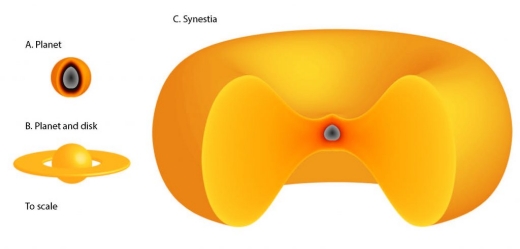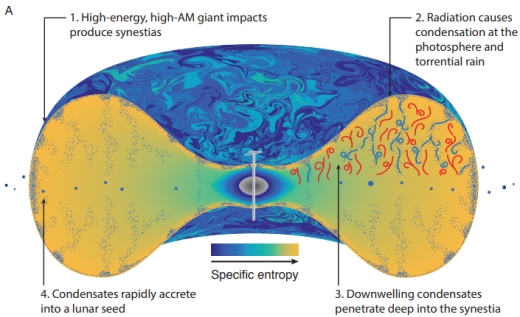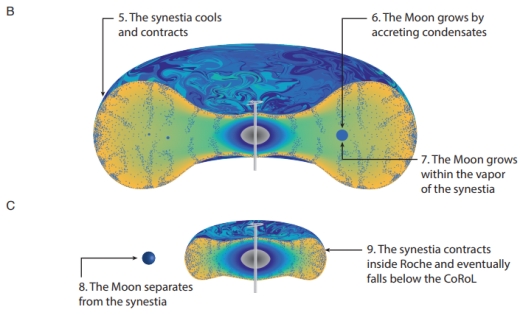Simon Lock and Sarah Stewart are intent upon revising our views on how the Moon was formed. Lock is a Harvard graduate student who last year, in company with Stewart (UC-Davis) presented interesting work on what the duo are calling a ‘synestia,’ which is the kind of ‘structure’ resulting from the collision of huge objects. Current thinking about the Moon is that it formed following the collision of a Mars-sized object with the Earth, two huge objects indeed.
What Lock and Stewart asked is whether this formation scenario can produce the result we see today. What it calls for is the ejection of material that forms into a disk and, through processes of accretion, gradually becomes the Moon. The problem with it, says Lock, is that it’s a very hard trick to pull off:
“Getting enough mass into orbit in the canonical scenario is actually very difficult, and there’s a very narrow range of collisions that might be able to do it. There’s only a couple-of-degree window of impact angles and a very narrow range of sizes … and even then some impacts still don’t work.”
Perhaps we’ve misunderstood the original, massive collision. An adjusted formation scenario could explain why some volatile elements like potassium, sodium and copper are less abundant on the Moon than the Earth, and why isotope ratios for the Earth and the Moon are nearly identical. The ‘synestia’ hypothesis works like this: We still begin with an impact, but the assumed disk of raw materials never forms. Instead, the angular momentum of both colliding bodies is added together, creating a vast, indented disk much bigger than either object.
I’m going to drop back to an earlier Lock and Stewart paper for an illustration here.

Image: The structure of a planet, a planet with a disk and a synestia, all of the same mass. Credit: Simon Lock and Sarah Stewart.
The 2018 paper describes a synestia as:
…an impact-generated structure with Earth-mass and composition that exceeds the corotation limit (CoRoL). Synestias are formed by a range of high-energy, high-AM [angular momentum] collisions during the giant impact stage of planet formation (Lock and Stewart, 2017, hereafter LS17). A synestia is a distinct dynamical structure compared to a planet with a condensate-dominated circumplanetary disk, and, as a result, different processes dominate the early evolution of a synestia.
So the synestia we get from major collisions — and these should be frequent in young planetary systems — is a rapidly rotating, partially vaporized object, molten or gaseous material expanding in volume, an object in the shape of a squashed doughnut without any solid surface. The synestia cannot rotate like a solid body because of variations in rotational rate and thermal energy, so we get an inner region rotating one way and an outer region moving at orbital speeds. Perhaps 10 percent of the Earth’s rock is vaporized, while the rest becomes liquid.
When Lock and Stewart set up simulations of cooling synestias and examine them with dynamic, thermodynamic and geochemical calculations, they find that a ‘seed’ forms within the synestia, a gathering of liquid rock that forms off-center and grows as the structure cools, with vaporized rock condensing and falling toward the center of the synestia. As some of this material strikes the ‘seed’ that will become the Moon, it begins to grow. The Moon eventually emerges from the vapor of the synestia as condensation continues and the synestia recedes within the lunar orbit, with the remainder of the spinning debris coalescing into the Earth.
From the paper:
Most high-energy, high-AM giant impacts can produce synestias. The formation of the Moon within a terrestrial synestia can potentially reproduce the lunar bulk composition, the isotopic similarity between Earth and the Moon, and the large mass of the Moon. If the post-impact body also had high obliquity, the same giant impact may trigger a tidal evolution sequence that explains the present day lunar inclination and the AM of the Earth-Moon system…

Image: Part of the paper’s Figure 18, illustrating Moon formation within a terrestrial synestia. Credit: Lock & Stewart.
The next image, likewise part of Figure 18 in the paper, shows the emergence of the Moon within the synestia as the latter contracts. Credit: Lock & Stewart.

The impact scenario for lunar formation thus shifts to a study of the properties of the synestia that produced the Moon. The similarity in isotopes between the Earth and the Moon is an issue because simulations of giant impacts under the older model produce a lunar disk made primarily of material from the impacting body. But isotope ratios vary among the planets. We would expect differences within these ratios if the Moon formed largely from the impactor’s materials.
Under the synestia model, Earth and Moon emerge from the same cloud of vaporized rock, explaining the isotopic similarity. In this scenario, a planetary satellite forms inside the planet it will orbit. Lock and Stewart explain the Moon’s lack of volatile elements by the same formation story, with the forming Moon surrounded by high-temperature material from the synestia. The paper adds:
The MVEs [moderately volatile elements] that are not incorporated into the Moon remain in the synestia. As the synestia cools and contracts within the lunar orbit, the remaining MVEs are destined to be incorporated into the bulk silicate Earth.
This is a complicated model, but Stewart points out in this Harvard news release that it replicates features of the Moon’s composition that are otherwise hard to explain. Further exploration of synestias will be useful as we model what happens in early exoplanet systems, where collisions on a similar colossal scale should be a feature of planet formation.
The paper is Lock et al., “The Origin of the Moon within a Terrestrial Synestia,” Journal of Geographysical Research: Planets 28 February 2018 (abstract / preprint). The 2017 paper is Lock & Stewart, “The structure of terrestrial bodies: Impact heating, corotation limits, and synestias,” Journal of Geophysical Research: Planets 122 (2017). Abstract / preprint.



Perhaps these untouched lunar surface samples from Apollo may reveal something new about how Earth’s natural satellite was formed using modern technologies:
https://www.space.com/39870-should-we-open-sealed-apollo-moon-samples.html
Accompanying paper:
https://www.hou.usra.edu/meetings/lpsc2018/pdf/1253.pdf
Nice. These large impact scenarios are something I know virtually nothing about. Thus a naive question. I presume that most impacts will have been high angular momentum events. If large satellites can be expected to often coalesce in the process, do most form near the outer boundary of the Hill sphere? In other words why do all other rocky worlds in the inner system have no large moons?
“…In other words why do all other rocky worlds in the inner system have no large moons?” Excellent point, it seems it should be quite common.
Plus, what mechanism moved Luna, formed inside the synestia and close to the parent body, away from Earth to it’s current (large) 250,000 mile orbit?
The answer to your question is, primarily the oceans. The drag of the moons gravity on the oceans (tides) steals rotational energy from the Earth and transfers it to the moon. Moving it to a higher orbit. This has been going on since its creation. My own silly suggestion about the boundary of the Hill sphere ties into that. Assuming Venus or Mars had substantial oceans, a moon that formed near the Hill boundary might have escaped through the same mechanism. It’s not the likely reason for the dearth of large moons in the inner solar system. Perhaps high angular momentum collisions are just not the norm.
The iron core of the Theia went into the Earth and because the Earth’s larger metal core. The Earths entire mantle was blasted of into space and became the Moon. Earth also has plate tectonics which bring elements up from the mantle through volcanism. The Earth is also a larger planet so there might be more metals and radioisotopes, decay and heat from them?
Not just young systems.
Some simulations show a Mercury/Venus collision in a few million millennia, and a few old systems have dust clouds hinting at recent collisions.
But most would be young.
An alternate theory: Fewer volatiles sodium and potassium have been lost due to Earth’s high escape velocity: https://sservi.nasa.gov/articles/scientists-explain-why-moon-rocks-contain-fewer-volatiles-than-earth-rocks/ Maybe copper was retained by gravity the same way?
Fascinating, just fascinating. Any chance we see any of the sorts in the younger systems?
The developmental time frame in this scenario is incredibly short. The synesia would have released the moon within about 10 years. Witnessing a similar scale event at just that span of time in another stellar system would be a really rare discovery.
Another example of a lack of data. Venus is similar in size to the Earth and if it had been hit by a massive body with high angular momentum possibly it would have a large moon? Mars and Mercury much smaller so the same process might not be possible. If we get to the point of being able to study many other extrasolar planets at the level of resolution of their moons we may begin to get some idea of whether or not these ideas are valid.
Why do Mercury and especially Venus have such slow rotation rates? 59 and 243 days, respectively. Was it due to a hit or two from another large body that they ended up absorbing but did not also create a moon in the process?
Mercury looks to have got stuck in a resonance and Venus has its huge atmosphere acting as a brake but also it can also speed it up, the current rotation rate may not be the same as it was millions of years ago.
And why does Mars’ rotation rate almost exactly match Earth’s yet the Red Planet only has two tiny moons, at least at present?
Since this new synestia model of formation overcomes the requirement of prior models that masses, chemistry, inclination, velocity of the colliding objects to be “just so”, it conversely predicts that Earth moon style systems should not be uncommon or at least not rare. Future observations of exo-solar systems may help us resolve whether Earth moon is rare or not.
I agree. The heavier elements and iron from Theia go into the core of the Earth which is why Earth has a large iron core. The angular momentum goes into the fast rotation of the Earth and gives it a magnetic field. A collision that destroyed both Theia and Earth would completely leave no third planet round the Sun and nothing but debris and smaller asteroids distributed in a separate orbits around the Sun which might not recombine into a Earth sized planet due to the extreme kinetic energy and escape velocity of the ejected matter from the collision.
The Theia impact is hypothesized to not have been a head on collision but hit the side. A head on collision would have had more kinetic energy.
Massive Space Structures Have Surprising Connection to Quantum Mechanics Math.
“Enormous disks of stars or debris can operate under the same rules as subatomic particles, changing based on the Schrodinger equation, which physicists use to model quantum-mechanical systems.”
It does have a resemblance to Hydrogen electron orbitals!
https://www.space.com/39881-massive-space-structures-quantum-mechanics-math.html
I wonder if a torus shaped station can be accreted into existance over time…
Lunar Meteorite Helps Explain Water On The Moon
Press Release – Source: TOHOKU UNIVERSITY
Posted June 14, 2018 11:05 PM
A team of Japanese scientists led by Masahiro Kayama of Tohoku University’s Frontier Research Institute for Interdisciplinary Sciences, has discovered a mineral known as moganite in a lunar meteorite found in a hot desert in northwest Africa.
This is significant because moganite is a mineral that requires water to form, reinforcing the belief that water exists on the Moon.
“Moganite is a crystal of silicon dioxide and is similar to quartz. It forms on Earth as a precipitate when alkaline water including SiO2 is evaporated under high pressure conditions,” says Kayama. “The existence of moganite strongly implies that there is water activity on the Moon.”
http://spaceref.com/moon/lunar-meteorite-helps-explain-water-on-the-moon.html